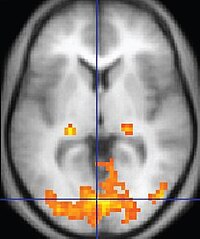
Photo from wikipedia
We used auditory-evoked magnetic fields to investigate the properties of echoic memory. The sound stimulus was a repeated 1-ms click at 100 Hz for 500 ms, presented every 800 ms. The phase of… Click to show full abstract
We used auditory-evoked magnetic fields to investigate the properties of echoic memory. The sound stimulus was a repeated 1-ms click at 100 Hz for 500 ms, presented every 800 ms. The phase of the sound was shifted by inserting an interaural time delay of 0.49 ms to each side. Therefore, there were two sounds, lateralized to the left and right. According to the preceding sound, each sound was labeled as D (preceded by a different sound) or S (by the same sound). The D sounds were further grouped into 1D, 2D, and 3D, according to the number of preceding different sounds. The S sounds were similarly grouped to 1S and 2S. The results showed that the preceding event significantly affected the amplitude of the cortical response; although there was no difference between 1S and 2S, the amplitudes for D sounds were greater than those for S sounds. Most importantly, there was a significant amplitude difference between 1S and 1D. These results suggested that sensory memory was formed by a single sound, and was immediately replaced by new information. The constantly-updating nature of sensory memory is considered to enable it to act as a real-time monitor for new information.
Journal Title: Scientific Reports
Year Published: 2019
Link to full text (if available)
Share on Social Media: Sign Up to like & get
recommendations!